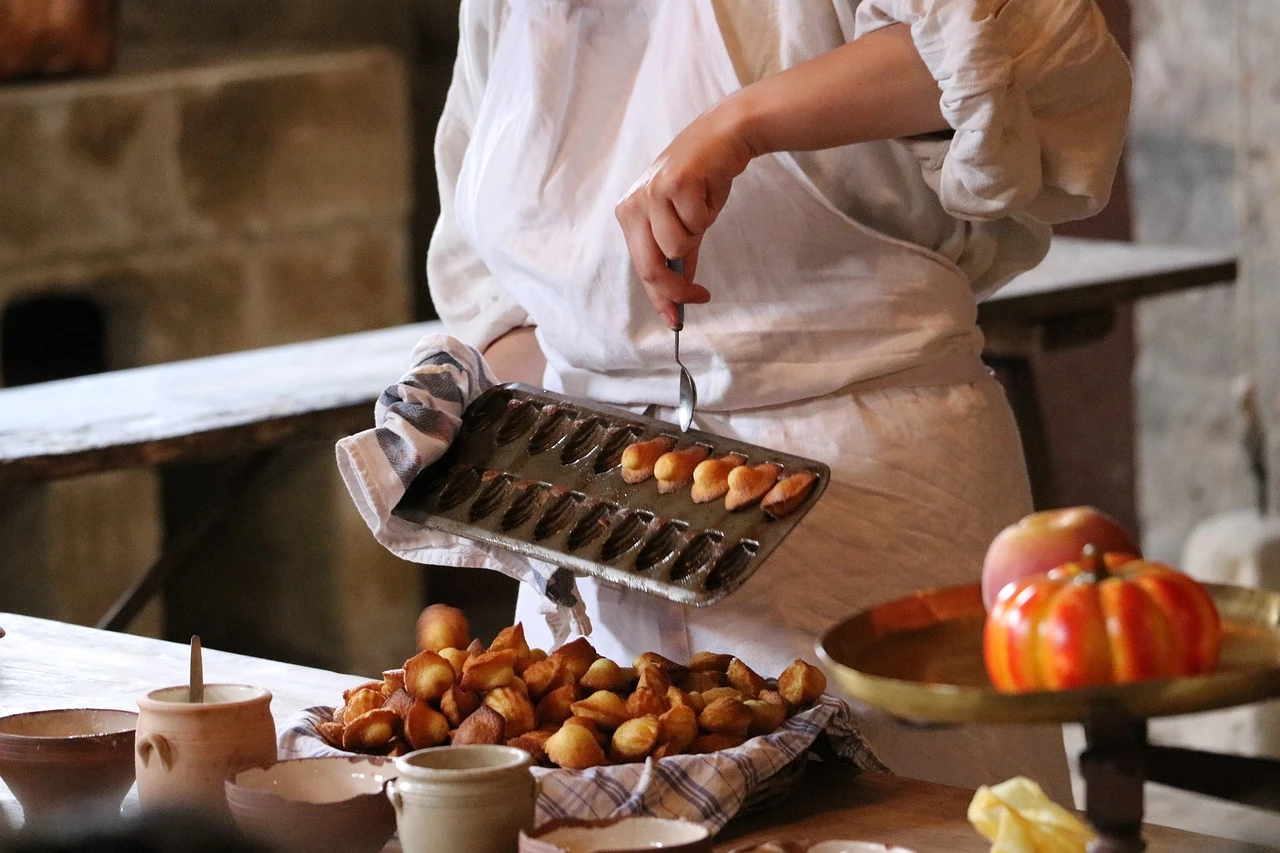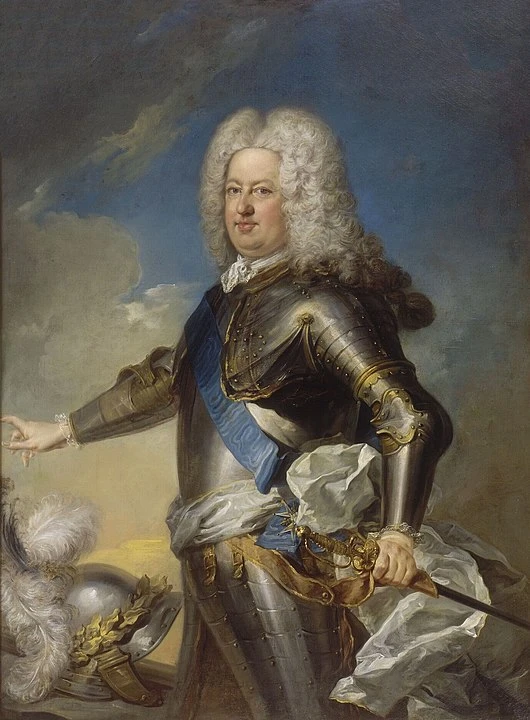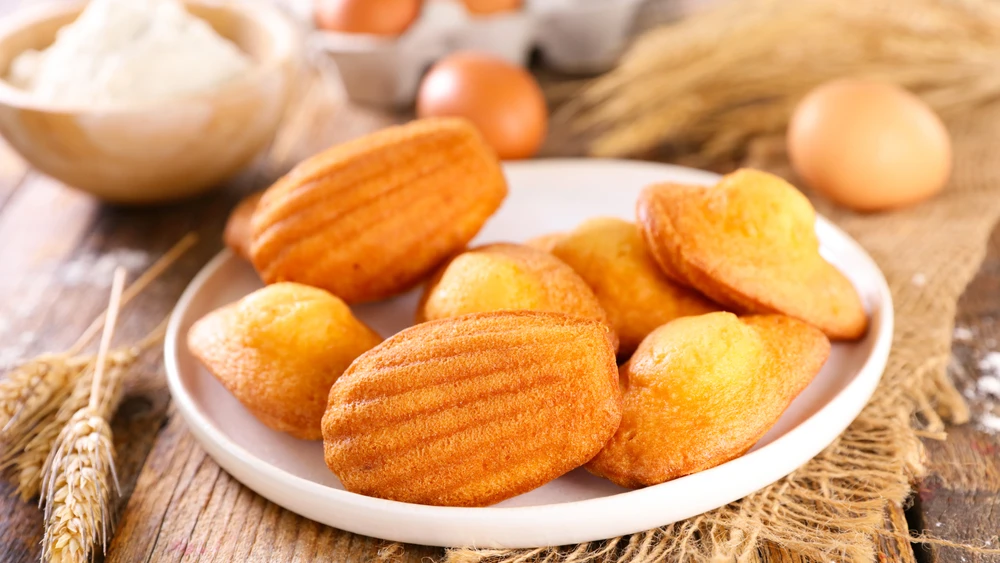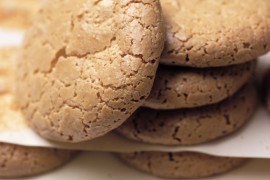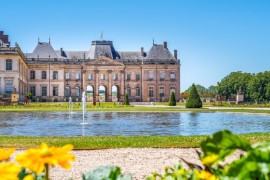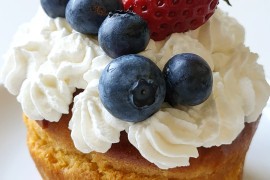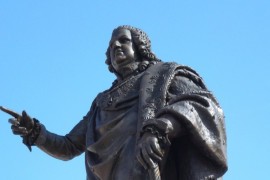Easy recipe for homemade madeleines
The ingredients
-
255 g flour (T55)
-
3 eggs
-
200 g sugar
-
125 g de beurre
-
5 cl milk
-
1 sachet vanilla sugar
-
1 sachet baking powder (5 g)
The process
Image par SweetMellowChill de Pixabay
-
Gently melt the butter without letting it cook.
-
In a large bowl, mix flour, sugar, vanilla sugar and yeast.
-
Add the eggs and milk and mix until smooth.
-
Add the melted butter and whisk for at least a minute.
-
Let stand 2 hours at room temperature under a cloth.
-
Preheat oven to 220 °C..
-
Burn your molds (metal is ideal).
-
Fill each impression halfway.
-
Bake 5 minutes at 200 °C, then 6 minutes at 180 °C.
Chef's tip
To get the characteristic bump, line the filled pan and leave it a few minutes in the fridge before putting in the oven.
A stroke of heat at the start makes the pastry puff up.
And if you like subtle flavors, try lightly warm hazelnut butter....
Madeleine, why a name for a cake?
A sweetness born of a king in a hurry and an inspired maid
Some say that the madeleine is very old. They were made as far back as the Middle Ages, it is said, and baked in scallops - which would explain the little cake's recognizable shape.
But the most famous version takes us to Lorraine, in the 18th century, in the wake of King Stanislas, Duke of Lorraine and Bar, a great lover of good food and gourmet surprises.
Portrait of Stanisłas Iby Jean-Baptiste van Loo, preserved at the Château de Versailles.
When Stanislas arrives unannounced in Commercy
As was often the case, King Stanislas changed residences according to his mood. He had his grand château at Lunéville, already dubbed "the Versailles of Lorraine", and the more intimate one at Commercy, in the Meuse.
One day, he turned up unannounced: his cook, caught off guard, hadn't planned anything for dessert. Furious, the chef slams the door. Panic in the kitchen!
The brilliant idea of a young woman: Madeleine Paulmier
This is where Madeleine Paulmier, the cook's helper, comes in. She improvises a dessert with the means at hand, according to a recipe handed down by her grandmother.
When the cupcakes arrive on the table, Stanislas tastes one... and falls under its spell.
He asks to meet the one who prepared this marvel. He is introduced to Madeleine. The king congratulates her and asks for more of these sweets, which will henceforth take the name of their inventor.
The Château de Commercy in Madeleine's time source: wikicommons
The madeleine, symbol of Commercy and pride of Lorraine
Even today, Commercy continues to make its madeleines. In the past, they were sold in hatboxes on stationary trains, which travelers brought back as gourmet souvenirs.
"La Cloche Lorraine" continues this chewy tradition, while in Liverdun, near Nancy, they've been making a slightly firmer, but just as tasty, madeleine since the early XXᵉ century.
Two different, but inseparable sisters from the same Lorraine family.
Madeleines / Image by Chatham172/Shutterstock
FAQ: everything you need to know about Commercy madeleine
What is the origin of madeleine?
According to legend, Madeleine Paulmier, in Commercy in 1755, improvised this cake for Duke Stanislas.
Why is the cake called "madeleine"
Because it bears the name of its creator, Madeleine Paulmier.
How to get the typical hump
A very hot oven (230 °C) to start with, a rest of the dough in a cool place, and well-filled molds.
Can you make madeleines without butter?
Yes, with margarine or oil, but the taste will be less rich and the texture less melting.
Where to taste the best madeleines?
In Commercy, at La Cloche Lorraine, or in Liverdun, where the tradition has been carried on for over a century.
3 original recipes for madeleines
🍯 1. Madeleines with lime blossom honey and lemon zest
A fragrant sweetness, soft to the core, with a floral touch.
Ingredients (for 18 madeleines) :
-
100 g unsalted butter
-
2 eggs
-
80 g blond sugar
-
1 tablespoon linden honey
-
100 g flour
-
1/2 sachet baking powder
-
Finely grated zest of an untreated lemon
-
A pinch of salt
Preparation:
-
Melt the butter over low heat, then leave to cool.
-
Whisk the eggs, sugar and honey until the mixture turns white.
-
Add the flour, baking powder and salt, then the lemon zest.
-
Pour in the melted butter and stir.
-
Let the dough rest 1 hour in the fridge.
-
Fill the buttered and floured molds ¾ full.
-
Bake at 210 °C (th.7) for 5 min, then turn down to 180 °C and bake for another 6 to 8 min.
-
Turn out lukewarm.
👉 Thermal shock creates the pretty golden bump typical of madeleines!
Tip: serve with a light tea or herbal flower tea.
🍫 2. Dark chocolate and fleur de sel brownie-style madeleines
A fusion between the softness of the madeleine and the intensity of the chocolate.
Ingredients (for 18 madeleines) :
-
90 g de beurre
-
100 g dark chocolate (70%)
-
2 eggs
-
80 g brown sugar
-
60 g flour
-
1/2 sachet baking powder
-
1 pinch of fleur de sel
Preparation:
-
Melt the butter and chocolate together in a bain-marie.
-
Whisk the eggs and sugar until frothy.
-
Stir in the flour, baking powder and fleur de sel.
-
Pour in the melted butter-chocolate mixture and stir gently.
-
Rest in the cold for at least 30 minutes.
-
Fill the madeleine moulds.
-
Bake at 200 °C for 10 min.
-
Let cool before unmolding.
Tip: add a melting heart of caramel or a burst of walnut before baking for extra indulgence.
🌸 3. Madeleines with lavender and almonds
A Southern recipe that smells like a vacation in Provence.
Ingredients (for 18 madeleines) :
-
2 eggs
-
100 g white sugar
-
100 g melted butter
-
100 g flour
-
1/2 sachet baking powder
-
1 tablespoon dried lavender flowers (edible)
-
30 g almond powder
-
1 teaspoon bitter almond extract
-
1 pinch salt
Preparation:
-
Gently heat the butter with the lavender, leave to infuse for 10 minutes, then filter.
-
Whisk the eggs with the sugar.
-
Add the flour, baking powder, almond powder and salt.
-
Pour in the infused butter and almond extract. Mix well.
-
Chill for 1 h.
-
Bake at 200 °C for 8 to 10 min.
-
Leave to cool on a wire rack.
Tip: a drizzle of lavender honey on top just before serving enhances the fragrance wonderfully.

